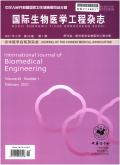Black phosphrous quantum dot (BPQD)-loaded erythrocyte membrane vesicles for phothothermal therapy in breast cancer
引用次数: 0
Abstract
Objective To investigate the method of preparing black phosphrous quantum dot (BPQD)-loaded erythrocyte membrane nanovesicles (BPQD-EMNVs), and to study its efficiency in photothermal therapy for breast cancer. Methods Fresh red blood cells (RBCs) of healthy mice were extracted to prepare erythrocyte membrane, and BPQD-EMNVs were prepared by sonication method. The morphology of BPQD-EMNVs was observed by a transmission electron microscopy. The particle size distribution was measured by a nano-particle size and Zeta potential meter. The encapsulation efficiency of BPQD was determined by inductively coupled plasma emission spectrometry. The uptake rate of BPQD-EMNVs was observed by a laser scanning confocal microscope. 4T1 tumor-bearing Balb/c mice were randomly divided into PBS, EMNVs, BPQD and BPQD-EMNVs groups, and the tumor sites were irradiated with 808 nm near-infrared light for 10 min after 4 hours of tail vein injection. The growth of the tumors was continually observed. Results The prepared BPQD-EMNVs have a regular spherical shape with an average particle diameter of 228 nm and an encapsulation efficiency of about 47%. Cellular uptake in vitro experiments showed that BPQD-EMNVs were rapidly taken up by 4T1 tumor cells. The results of animal in vivo experiments showed that BPQD-EMNVs had the highest enrichment after 4 h of injection at the tumor site, and BPQD-EMNVs could effectively kill tumor tissues after 10 min of 808 nm near-infrared light irradiation. Conclusions The BPQD-EMNVs are easy to prepare, and the prepared nanovesicles have good biocompatibility and photothermiotherapy effect, which is expected to be a promising method for breast cancer therapy. Key words: Erythrocyte membrane; Breast cancer; Black phosphorous quantum dot; Nanovesicles; Photothermal therapy黑磷量子点(BPQD)负载红细胞膜囊泡光热治疗乳腺癌
目的研究黑磷量子点(BPQD)负载红细胞膜纳米囊泡(BPQD- emnvs)的制备方法,并研究其光热治疗乳腺癌的效果。方法提取健康小鼠新鲜红细胞制备红细胞膜,超声法制备bpqd - emnv。透射电镜观察BPQD-EMNVs的形态。采用纳米粒度和Zeta电位仪测量了颗粒的粒径分布。采用电感耦合等离子体发射光谱法测定BPQD的包封效率。用激光扫描共聚焦显微镜观察BPQD-EMNVs的摄取速率。将4T1荷瘤Balb/c小鼠随机分为PBS组、EMNVs组、BPQD组和BPQD-EMNVs组,尾静脉注射4 h后,用808 nm近红外光照射肿瘤部位10 min。持续观察肿瘤的生长情况。结果制备的bpqd - emnv呈规则球形,平均粒径为228 nm,包封率约为47%。体外细胞摄取实验表明,BPQD-EMNVs被4T1肿瘤细胞快速摄取。动物体内实验结果表明,BPQD-EMNVs在肿瘤部位注射4 h后富集程度最高,808 nm近红外光照射10 min后BPQD-EMNVs能有效杀伤肿瘤组织。结论BPQD-EMNVs制备简单,制备的纳米囊泡具有良好的生物相容性和光热治疗效果,有望成为一种有前景的乳腺癌治疗方法。关键词:红细胞膜;乳腺癌;黑磷量子点;Nanovesicles;光照疗法
本文章由计算机程序翻译,如有差异,请以英文原文为准。
求助全文
约1分钟内获得全文
求助全文

 求助内容:
求助内容: 应助结果提醒方式:
应助结果提醒方式:


